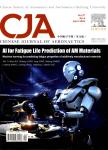Investigation on the interface damage in drilling low-stiffness CFRP/Ti stacks
Investigation on the interface damage in drilling low-stiffness CFRP/Ti stacks作者机构:School of Mechanical Engineering Northwestern Polytechnical University
出 版 物:《Chinese Journal of Aeronautics》 (中国航空学报(英文版))
年 卷 期:2019年第32卷第9期
页 面:2211-2221页
核心收录:
学科分类:08[工学] 082503[工学-航空宇航制造工程] 0802[工学-机械工程] 0825[工学-航空宇航科学与技术] 0801[工学-力学(可授工学、理学学位)]
基 金:co-supported by the National Natural Science Foundation of China (Nos. 51705426 and 51475379) the Key Research and Development Plan of Shaanxi Province of China (No. 2017GY-101)
主 题:Coupling effects Drilling Interface damage Interlayer gap Thin walled structures
摘 要:Carbon fiber reinforced plastic and titanium alloy(CFRP/Ti) stacks have been widely used as aerospace structures because of their excellent combination of physical properties. Interface damage caused by interface gaps, significantly different from that of metal/metal stacks, is a common problem in the through-hole drilling of CFRP/Ti stacks with low stiffness. In this study, a force–deformation coupling model was developed to further examine the formation mechanism and the control method of interface damage. Firstly, the coupling model was built considering the interaction between the thrust force and the deformation. To solve this model, a numerical method was proposed in which specific cutting coefficients were calibrated using only the thrust force of rigid stacks. Secondly, drilling experiments were performed with different feed rates and bending stiffness. Experimental results indicate that interface damage mainly includes interlayer chips and surface damage of CFRP layers. The surface damage, which is irreparable, is caused by the rotary extension of metal chips along the interlayer gap. Thirdly, variations of the interface gap were calculated with the coupling model that had been verified by measured thrust forces. The damage area was found to have a linear dependence relation with the interlayer gap. However, in conditions of large gap sizes, the interface damage areas increased with the interlayer gap at high feed rates, while decreasing slightly at low feed rates. This phenomenon was satisfactorily explained by the presented model. Finally, a method was proposed to determine the appropriate pressure exceeding which no interlayer damage will occur. Additional drilling experiments proved the method effective. This study leads to further understanding of the forming mechanism of interlayer damage and of selecting appropriate parameters in drilling low-stiffness composite/metal stacks.



